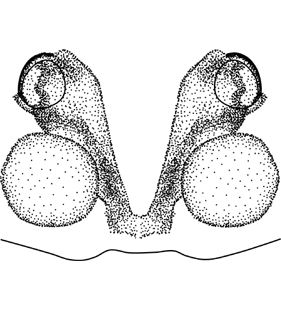Apostenus crespoi Lissner, 2017
Description
Male
Male unknown.
Female
When alive this is a bright reddish-orange species with distinct chevrons on opisthosoma and with indistinct leg annulations. Colours of prosoma and legs fade to yellow-brown in alcohol except for the dark-brown fovea, the very faint brown reticulations and the annulations of the legs becoming indiscernible.
Prosoma smooth with a narrow, protruding head. Eyes in a compact group and of normal size. PME separatedby a little more than half a diameter, the sockets of the remaining eyes touching. Eyes of PER equal in size, larger than the AME but smaller than ALE. Labium shaped like a triangle with rounded corners, more than 1.5 times wider than long, slightly less than half the length of the endites. Cheliceral promargin with three minute, discrete teeth, retromargin with two small discrete teeth. Sternum scutiform, projecting between coxae IV. Opisthosoma elongate oval, with four chevrons, densely covered with hairs which seem to fall off in alcohol. Femur I and II with two macrosetae in dorsal midline, III and IV with three. Femur I with additional strong prolateral macrosetae and two ventral macrosetae one of which is strong and light brown, second is thinner and black. Femur III and IV also with an additional prolateral macroseta in distal position and two ventral-prolateral macrosetae, also in distal positions. Patella I and II without macrosetae, III and IV each with a dorsal macroseta in distal position. Tibia I and II with five pairs of ventral macrosetae, Mt I and II with three pairs. Epigyne without a septum or median plate. The only external sclerotizations are the rather weakly sclerotized linings of the small copulatory openings which are circular-semicircular, and set apart anteriorly. The two halves of the vulva form a ‘V’ and are only bridged posteriorly by a thin bar.
Body length female: 3.2 mmAdditional information
Under stones on limestone grassland with bush encroachment.
The species most closely resembles Apostenus humilis Simon, 1932 and A. maroccanus Bosmans, 1999 based on build of the epigyne/vulva.
Frequency: Very rarely found
Distribution
Phenology
| Jan | Feb | Mar | Apr | May | Jun | Jul | Aug | Sep | Oct | Nov | Dec |
 |  |
Distribution List
"No references" does not mean that the species does not occur in this country, but that we have not yet inserted the reference for it. We are working on it.
References
Branco V V, Morano E, Cardoso P (2019) An update to the Iberian spider checklist (Araneae). Zootaxa 4614: 201-254 ![]()
Lissner J (2017a) New records of spiders (Araneae) from Portugal. Arachnologische Mitteilungen 54: 52-58 ![]()
WSC (2025) World Spider Catalog. Version 26. Natural History Museum Bern, online at http://wsc.nmbe.ch (28.2.2025) doi: 10.24436/2 ![]()

